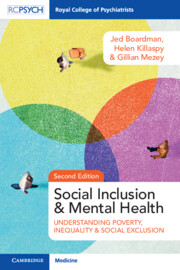Book contents
- Social Inclusion and Mental Health
- Reviews
- Social Inclusion and Mental Health
- Copyright page
- Contents
- Foreword to Second Edition
- Foreword to First Edition (2010)
- Preface
- Acknowledgements
- Chapter 1 Introduction: Poor, Excluded, and Unequal
- Section 1 Social Exclusion, Poverty, and Inequality
- Chapter 2 Social Exclusion: Basic Concepts
- Chapter 3 Social Exclusion: Applying the Paradigm to People with Mental Health Conditions – Key Aspects
- Chapter 4 Poverty and Deprivation: Getting Under the Skin
- Chapter 5 Poverty, Deprivation, and Social Exclusion in the United Kingdom
- Chapter 6 Poverty, Inequality, and Health
- Chapter 7 Social Policy, the Welfare State, and Social Exclusion
- Chapter 8 Mental Health Services and Policy in the United Kingdom
- Section 2 Participation of People with Mental Health Conditions
- Section 3 Including People
- Index
- References
Chapter 2 - Social Exclusion: Basic Concepts
from Section 1 - Social Exclusion, Poverty, and Inequality
Published online by Cambridge University Press: 24 November 2022
- Social Inclusion and Mental Health
- Reviews
- Social Inclusion and Mental Health
- Copyright page
- Contents
- Foreword to Second Edition
- Foreword to First Edition (2010)
- Preface
- Acknowledgements
- Chapter 1 Introduction: Poor, Excluded, and Unequal
- Section 1 Social Exclusion, Poverty, and Inequality
- Chapter 2 Social Exclusion: Basic Concepts
- Chapter 3 Social Exclusion: Applying the Paradigm to People with Mental Health Conditions – Key Aspects
- Chapter 4 Poverty and Deprivation: Getting Under the Skin
- Chapter 5 Poverty, Deprivation, and Social Exclusion in the United Kingdom
- Chapter 6 Poverty, Inequality, and Health
- Chapter 7 Social Policy, the Welfare State, and Social Exclusion
- Chapter 8 Mental Health Services and Policy in the United Kingdom
- Section 2 Participation of People with Mental Health Conditions
- Section 3 Including People
- Index
- References
Summary
The term ‘social exclusion’ appears to have originated in France in the 1970s and had a significant influence on European social policy before being taken up by the UK’s New Labour Government in the 1990s. This chapter outlines the concepts of social exclusion and some of the competing discourses associated with the term. Several notable definitions of the term are discussed before we settle on the CASE definition of ‘An individual is socially excluded if he or she does not participate in key activities of the society in which he or she lives’. The concepts of social exclusion may provide added value to discussing the more traditional concepts of poverty and deprivation. It is a relational concept and thus is of importance for developing a social psychiatric perspective. The relationship between Social Exclusion and Social Inclusion is complex and they are not necessarily polar opposites; rather, they may be viewed as a continuum, but a continuum of several dimensions which may differ over time and place. The chapter sets out a framework for examining the social exclusion of people with mental health conditions.
Keywords
- Type
- Chapter
- Information
- Social Inclusion and Mental HealthUnderstanding Poverty, Inequality and Social Exclusion, pp. 21 - 34Publisher: Cambridge University PressPrint publication year: 2022



